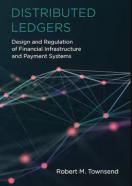One of my current areas of focus is distributed ledger technology. Distributed Ledgers: Design and Regulation of Financial Infrastructure and Payment Systems (MIT Press), is an economic analysis of the transformative potential and optimal design of distributed ledger technology (DLT), discussing key components and applications. (PLEASE NOTE: Distributed Ledgers is available for free via an open access grant here: https://doi.org/10.7551/mitpress/13382.001.0001)
DLT (and the related, but not synonymous, innovations of blockchain and Bitcoin) have the potential to transform economic organizations and financial structures. Yet, the subject is embroiled in controversy, hype, and terminological inconsistencies. Rather than get waylaid by alternative possible definitions of distributed ledgers, or decentralized ledgers, the book focuses more broadly on an economic analysis of what DLT can do. It begins by analyzing key individual components, comparing and contrasting the economics framework with the frameworks of computer science and data management disciplines to clarify the technology and initiate steps to combine these disciplines.
The book also covers familiar but key component parts of distributed ledgers: ledgers as financial accounts, e-messages and e-value transfers, cryptography, and contracts including multi-party mechanisms. Each component is discussed, evaluated, and illustrated through the context of historical and contemporary economies, with featured applications in both developed economies and emerging-market countries. These use cases are a hallmark of the monograph. A recurrent focus is the general-equilibrium impact of innovations and welfare gains from innovations featuring key components.
Contract theory is used to derive optimal arrangements, constrained only by obstacles to trade, featuring how the various aspects of ledgers can deepen infrastructure. Mechanism design and monetary theory are used to study public versus partitioned ledgers and improvements in payment systems. Prudential regulation, rather than being a barrier to innovation, can be improved with the use of DLT.
The goal of the book is to provide blueprints for the optimal design and regulation of financial systems given what we know today, including not only choices at the endpoints of the spectrum, of centralized versus decentralized systems, as in the hype, but the choice of hybrid forms in between. Each key component is assessed from both computer science and economic perspectives, and syntheses are offered. Overall, the monograph provides a vision for where we are heading, being clear about obstacles along the way.
Many of these ideas have been outlined in my working paper, "Distributed Ledgers: Innovation and Regulation in Financial Infrastructure and Payment Systems."
